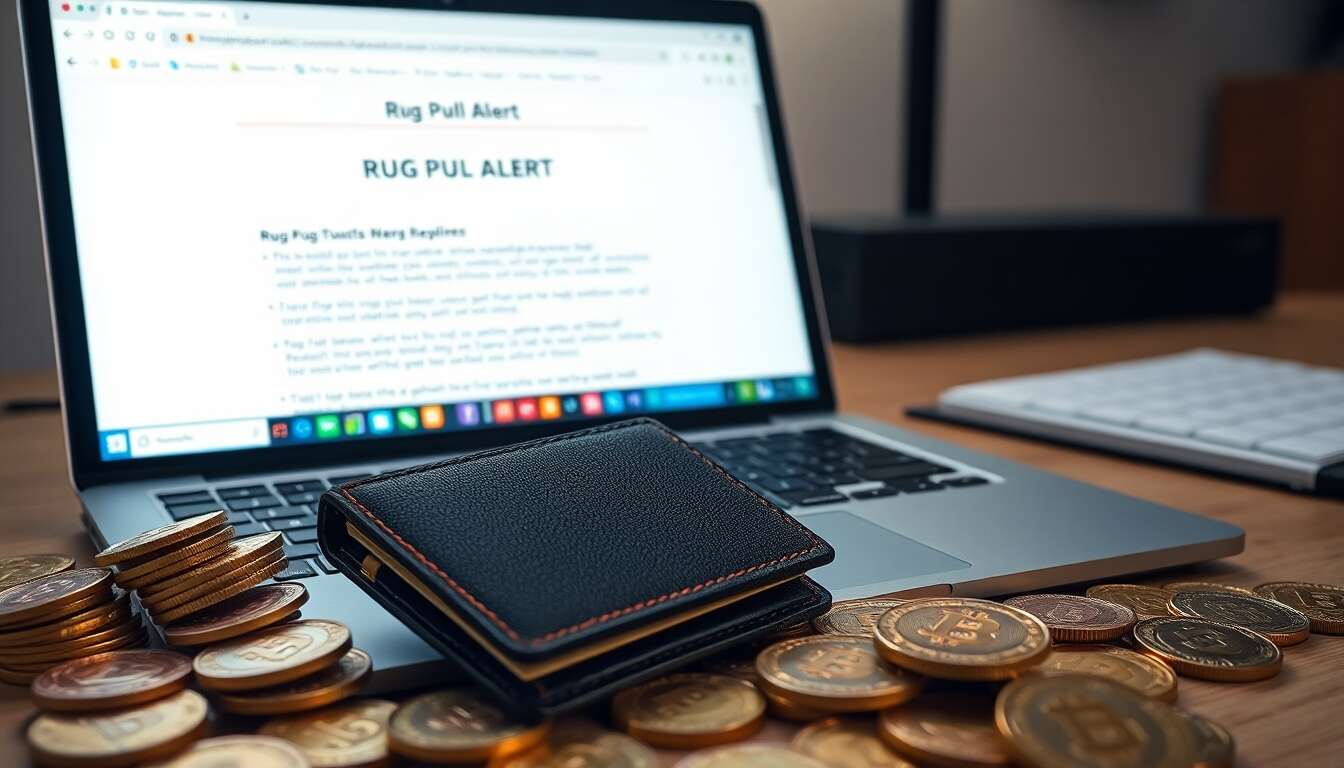As the allure of cryptocurrencies continues to captivate the global market, the need to remain cautious against emerging scams becomes increasingly important. These scams are not only sophisticated but also diverse, posing significant threats to both new and experienced investors.
Common scams in the crypto universe
Types of Common Scams
In the crypto world, several scams have become alarmingly prevalent. Among these, the rug pull stands out as a particularly devastating scheme. In these situations, developers promote a new project, attract significant investments, and then abruptly abandon the project, taking all the funds with them. It is a scam that plays on the excitement surrounding new blockchain projects.
Phishing is another widespread threat, where attackers send deceptive messages to trick users into revealing sensitive information or downloading harmful software. A common example includes fake cryptocurrency wallets designed to steal user credentials.
Ponzi schemes and fraudulent investment offers entice victims with promises of high returns on their cryptocurrency investments. These schemes often collapse, leaving investors with significant losses. Additionally, acquaintance scams leverage trust, where friends or acquaintances unknowingly or intentionally involve users in dubious projects, often under the guise of a beneficial opportunity.
Growth of Scams
The incidence of crypto scams has grown significantly. According to a report, over 14 billion dollars in cryptocurrencies were siphoned off by scammers in 2021, reflecting a staggering 79% increase from the previous year. This surge coincided with the booming crypto market, exploiting the optimism and rapid price hikes of digital assets.
Red Flags to Watch
Recognizing potential scams involves being alert to several warning signs. Be wary of any request for private keys or passwords, as these are personal credentials that should never be shared. Similarly, be cautious of messages offering « airdrops » or proposing quick profits, as these are often ploys to engage the unsuspecting. Offers that appear too good to be true usually are, and skepticism is a valuable asset in navigating the crypto space.
Protection Tips
Protecting oneself against these scams requires a proactive approach. It is essential to verify sources and conduct thorough research before making any investment decisions. Employing secure and reputable platforms is a crucial step in safeguarding assets. Additionally, maintaining the confidentiality of sensitive personal information is vital to prevent unauthorized access.
The Need for Regulation
The current lack of comprehensive regulation in the cryptocurrency realm provides fertile ground for cybercriminals. With minimal oversight from authorities, the crypto world becomes a haven for fraudulent activities. This situation underscores the pressing need for a robust legal framework that can effectively deter scammers and protect investors.
Understanding crypto scams
Complexity of Crypto Scams
Crypto scams have evolved to become complex and multifaceted. They exploit the decentralized nature of cryptocurrencies, which, while offering freedom and autonomy, also opens avenues for malicious actors. Understanding the mechanics of these scams is crucial for investors to protect themselves effectively.
The Role of Technology
Advanced technological tools have enabled scammers to create convincing fake websites, conduct phishing attacks, and even simulate entire trading platforms. The anonymity afforded by blockchain technology can further complicate efforts to trace and recover stolen assets.
Psychological Manipulation
Scammers often employ psychological tactics to manipulate potential victims. They leverage fear, urgency, and greed to coerce individuals into making hasty decisions. By understanding these psychological triggers, investors can better guard against falling victim to scams.
Phishing: prevalent traps

How Phishing Works
Phishing in the crypto space typically involves sending fraudulent emails or messages that appear to be from legitimate sources. These messages often prompt the recipient to click on a link, leading to a fake website that mimics a genuine one. The unsuspecting user then enters their credentials, which are captured by the scammer.
Common Targets
Cryptocurrency exchanges and wallet providers are frequent targets of phishing scams. Attackers impersonate these entities to gain access to user accounts. Users must be vigilant and verify the authenticity of any communication they receive.
Preventive Measures
To avoid falling prey to phishing scams, users should never click on links in unsolicited emails. They should also use two-factor authentication to add an extra layer of security to their accounts. Regularly updating passwords and using unique passwords for different accounts are also effective strategies.
Fake investments and promises of quick gains
Identifying Fake Investment Opportunities
Fake investment schemes often promise high returns with little to no risk, which should immediately raise suspicion. These scams commonly feature celebrity endorsements or testimonials to create an illusion of legitimacy.
The Pyramid Scheme Connection
Many fake investment opportunities operate as pyramid schemes, where returns are paid to earlier investors using the capital of newer investors. Eventually, these schemes collapse, leaving most participants with losses.
Due Diligence
Before investing, individuals should conduct comprehensive due diligence. This includes researching the team behind the project, evaluating the whitepaper, and assessing the project’s viability. Skepticism and verification are paramount when evaluating investment opportunities.
The scam of fraudulent trading platforms

Mechanics of Fraudulent Platforms
Fraudulent trading platforms often mimic legitimate exchanges to deceive users. They entice users with attractive trading features and low fees, only to disappear with user funds once a significant amount has been deposited.
Warning Signs
Indicators of a fraudulent platform include a lack of transparency, insufficient contact information, and customer reviews reporting withdrawal issues. Users should be cautious of platforms that appear too good to be true.
Verification and Trust
To ensure a platform’s legitimacy, users should verify its registration and licensing. Engaging with community forums and seeking feedback from experienced traders can also provide valuable insights into a platform’s credibility.
Recognizing and protecting against rug pulls

Understanding Rug Pulls
Rug pulls are exit scams where developers suddenly abandon a project, taking investors’ funds with them. These scams are prevalent in DeFi (Decentralized Finance) projects, where liquidity pools can be drained quickly.
Identifying Rug Pull Risks
Red flags for potential rug pulls include anonymous teams, lack of a clear roadmap, and sudden changes in project direction. Investors should be cautious of projects that exhibit these characteristics.
Mitigation Strategies
Investors can protect themselves by diversifying their investments and avoiding projects with high centralization of tokens. Engaging with projects that have undergone audits and have transparent teams can also reduce the risk of rug pulls.
Solutions to avoid crypto scams
Educating Investors
Education is the most powerful tool in combating crypto scams. Investors should stay informed about emerging threats and continuously update their knowledge of security practices.
Utilizing Secure Platforms
Choosing well-established and reputable platforms for trading and investing is crucial. These platforms often have robust security measures in place to protect user funds.
Community Engagement
Engaging with the crypto community through forums and social media groups can provide valuable insights and warnings about potential scams. Community members often share experiences and advice, fostering a collaborative effort against scammers.
The crypto universe presents both immense opportunities and significant risks. Awareness and vigilance are essential for navigating this dynamic landscape. By understanding the various scams and employing protective measures, investors can safeguard their assets and participate more securely in the world of cryptocurrencies.



